Are cranberries low FODMAP? Both Monash University and FODMAP Friendly have lab tested fresh cranberries, dried, as well as cranberry juice and there are low FODMAP amounts of all.
Fresh Cranberries & FODMAPs
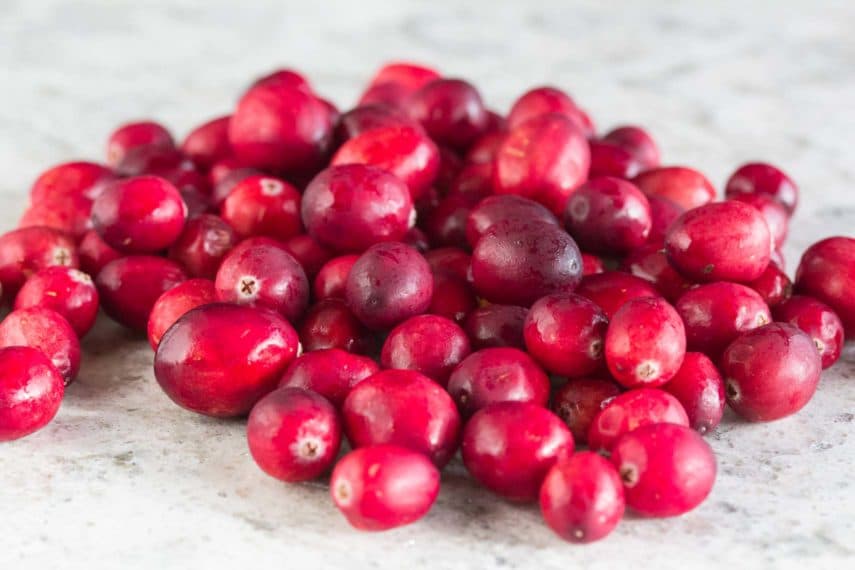
As of 11/21 Monash University added fresh cranberries to the smartphone app and a Green Light Low FODMAP serving is ½ cup or 50 g, becoming Moderate at 133 g
They have also stated on their site that 130 grams fresh, which is about a scant 1 ¼ cups, should be tolerated well. Since the app reports that they become moderate at 133 g, the site information does not contradict the information that has been on their site for years.
Also, please note that the weights given per volume in their site article do not agree with what we have we have confirmed in our Test Kitchen, however, the weights on their app are correct per volume.
Note that we confirmed these measurements in our Test Kitchen and certain cranberry grower sites list different volume amounts; we stand by our findings detailed here: 1 cup of cranberries averages 105 grams.
Dried Cranberries & FODMAPs

Both Monash University and FODMAP Friendly have lab tested dried cranberries.
Monash University had listed dried cranberries on their smartphone app; the Green Light amount was 1 Australian tablespoon or 13 grams, now updated to 22 g in subsequent tests. They contain fructans and become Moderate at 28 g.
FODMAP Friendly testing shows dried cranberries as low FODMAP at 17 g, with a max low FODMAP serving of 19 g. They contain fructans.
Cranberry Juice & FODMAPs

Monash used to have an app entry for cranberry juice listed as low FODMAP in amount of “1 glass or 200 ml” or 210 g. The problem with the app entry was that there was no further information. We contacted Monash June 2020 to ask whether the cranberry juice tested was sweetened with sugar, sweetened with high fructose corn syrup, fruit-juice sweetened or unsweetened, as these are all very common forms of cranberry juice in U.S. markets.
Monash responded that the juice tested did not contain any HFCS and their direct quote was, “it would probably be best to stick to cranberry juice without HFCS”. This did not fully answer our questions.
Presently the Monash app shows a 100% cranberry juice that is low FODMAP at 30 g, but does not become Moderate for fructans until 140 g.
The other entry is for cranberry drink with 27% juice. Again, we do not know everything we need to now about this product. Is it cane sugar sweetened? Does it contain HFCS? The app lists a low FODMAP serving of 162 g, becoming Moderate for fructans at 200 g.
FODMAP Friendly has lab tested cranberry juice, but we do not know what kind. Their tests suggest that a low FODMAP serving is 200 ml, with a maximum serving of 2000 ml (that is not a typo). Their tests show very small amounts of fructans and fructose.
About Cranberries In General
Cranberries are a dwarf evergreen shrub. In North America, Vaccinium macrocarpon is the standard for commercially available fresh, frozen and dried cranberries as well as cranberry juice. They are native to the U.S. and in fact, the Native American Wampanoag people, who lived around Aquinnah on Martha’s Vineyard in Massachusetts 10,000 years ago, ate wild cranberries known as sasumuneash. Cranberries found in Europe are Vaccinium oxycoccus, which is a smaller and speckled fruit.
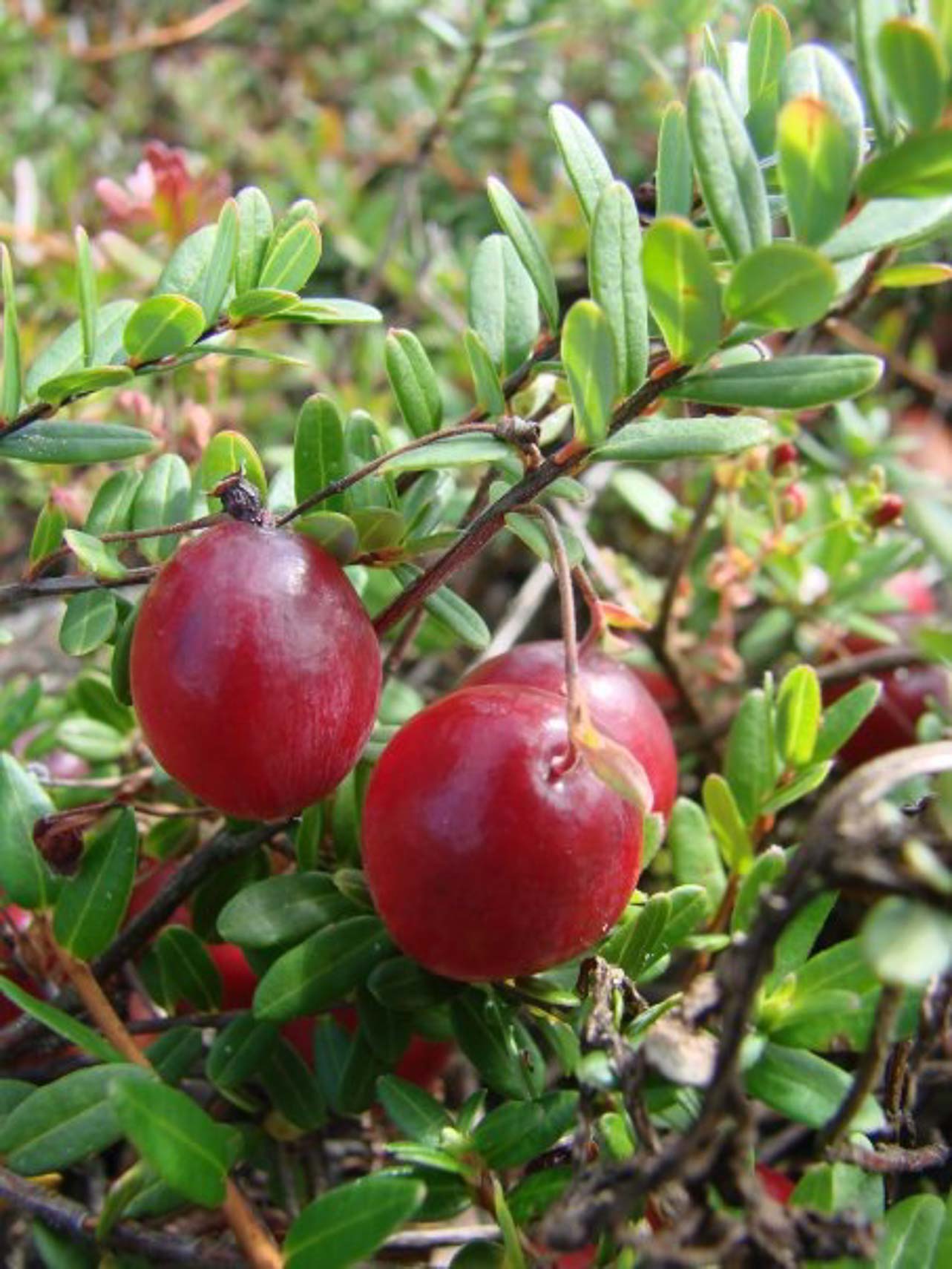
How to Buy
Cranberries come fresh, frozen and dried and are also made into juice and sauce, all available commercially.
Fresh are found in the market from early October through December.
As they can be frozen for up to a year, consider buying extra to have on hand.
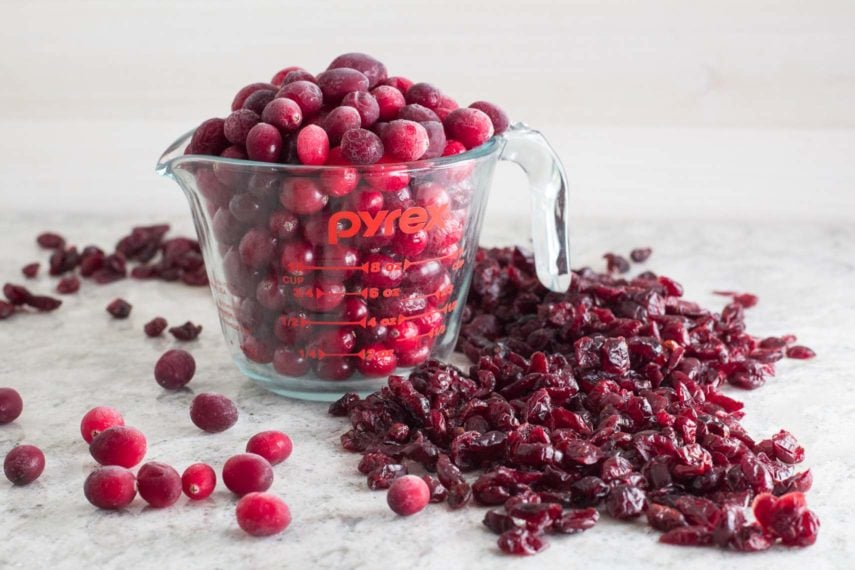
How to Prep & Cook
Most bags of fresh berries are pretty much ready to go. Sort them before using by picking out and discarding any stems, leaves or shriveled or bruised berries (see below).
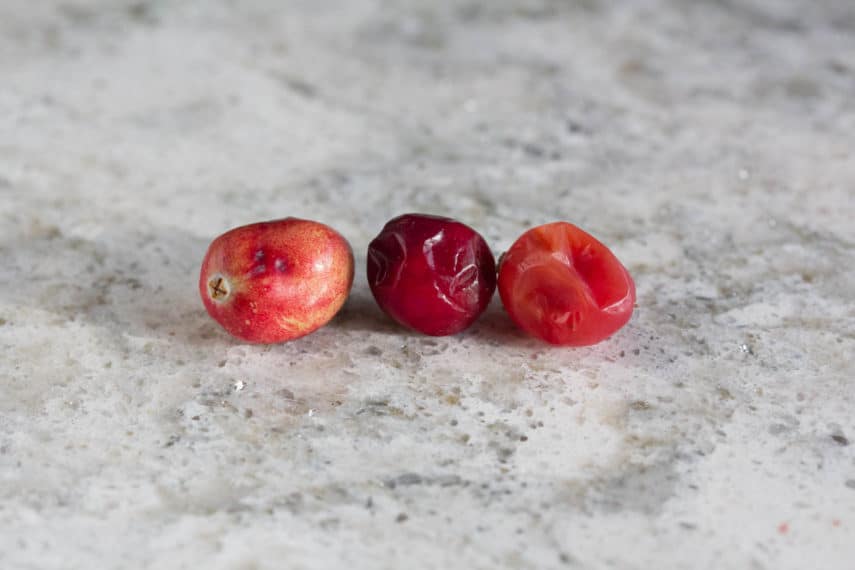
You can use frozen cranberries right out of the bag in most recipes, but follow individual recipe instruction if different.
How to Store
Fresh should be refrigerated and used within 1 month.
Cranberries may be frozen for up to 1 year, right in the bag they come in. We stock up to use throughout the year.
Dried cranberries should be stored in an airtight container and used before the “Best Buy” date on the package. They may also be frozen for up to two years.
Varieties
A very common variety is called Early Black, but Howes, Stevens, Ben Lear, Crimson Queen and the super dark Scarlet Knight are also common varieties. The varieties vary slightly in size. Trivia: According to the Cape Cod Cranberry Grower’s Association there are approximately 440 Early Black cranberries in one pound (455 g).
Some FAQs
- The cranberry got its name from the original Pilgrim name for this American indigenous fruit, which was “craneberry”. That name came from the fruit’s pink blossom that appears in the spring, which was thought to resemble the head of a local bird, the sandhill crane.
- Ocean Spray is the world’s largest cranberry grower.
- Dried cranberries are made from halved fresh berries.
- Ocean Spray harvests 400 million pounds of berries every year.
- The majority of cranberry bogs are in Massachusetts, New Jersey, Wisconsin and areas of eastern and western Canada. Some are also grown in Oregon and Washington State.
- There are vines that are over 150 years old that still produce fruit.
- In 1998 researchers at Rutgers University identified the concentrated tannins and proanthocyanidins in cranberries as the components that prevent Escherichia coli (E.coli), the primary bacteria responsible for UTIs, from attaching to cells in the urinary tract, which is why you hear about cranberry juice being recommended as a treatment.
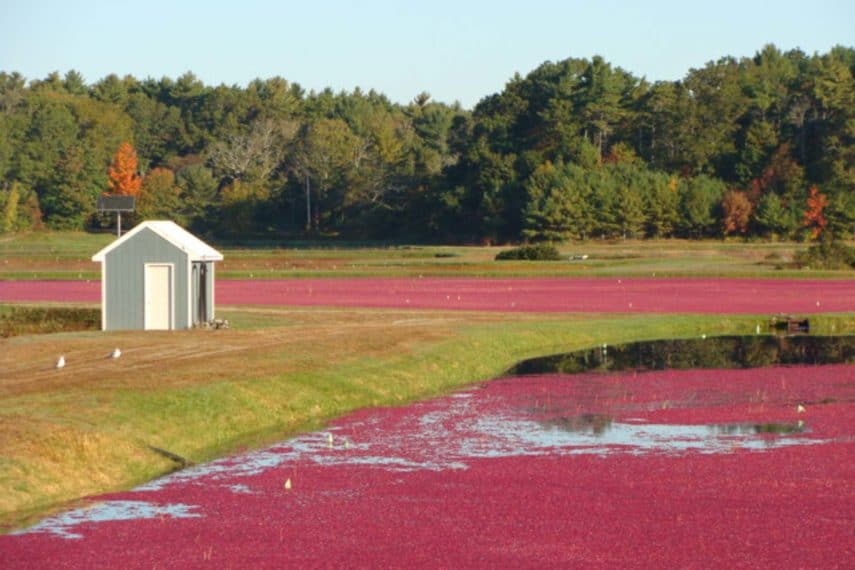
- Cranberries do not grow in water, but many are “wet harvested” (as seen above). Approximately 10% of a harvest is dry harvested and these berries are sold fresh at the supermarket. Wet harvesting, where bogs are flooded to help loosen the berries from the vine, is used for berries headed for juice, sauce and dried cranberry production. The berries have 4 air chambers, which allow them to float.
- As cranberries ripen they go from pale green to white and eventually to a deep crimson. The darker, riper berries will yield more juice, however, berries that still have a lighter red blush to them will often be higher in pectin and better at thickening sauce.
- Over 100 varieties are grown in North America.
- Approximately 46,000 plants can be grown on 1 acre.
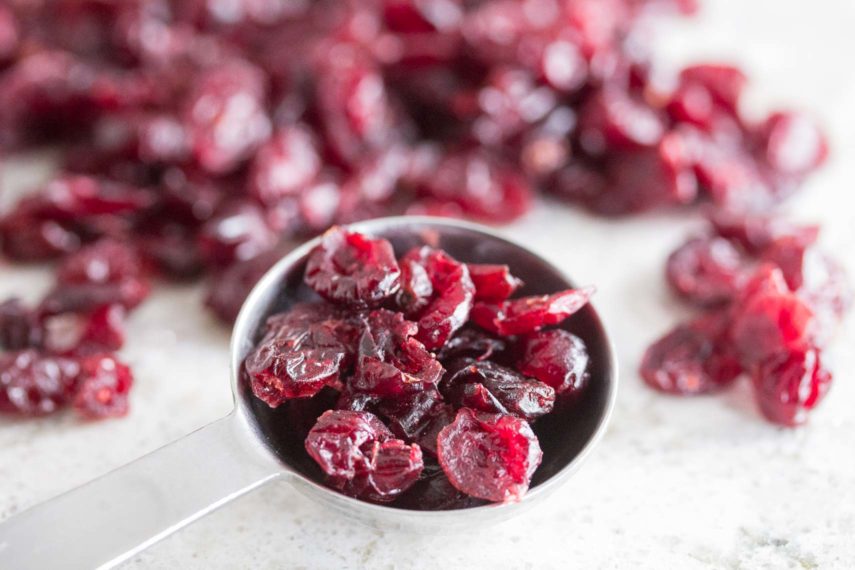
Cranberry Recipes
Of course we have many cranberry recipes for you, such as:


- Mini Gingerbread Muffins
- Cranberry Snowdrift Pie
- Sparkling Ginger Cranberry Punch
- Cranberry Grape Crisp
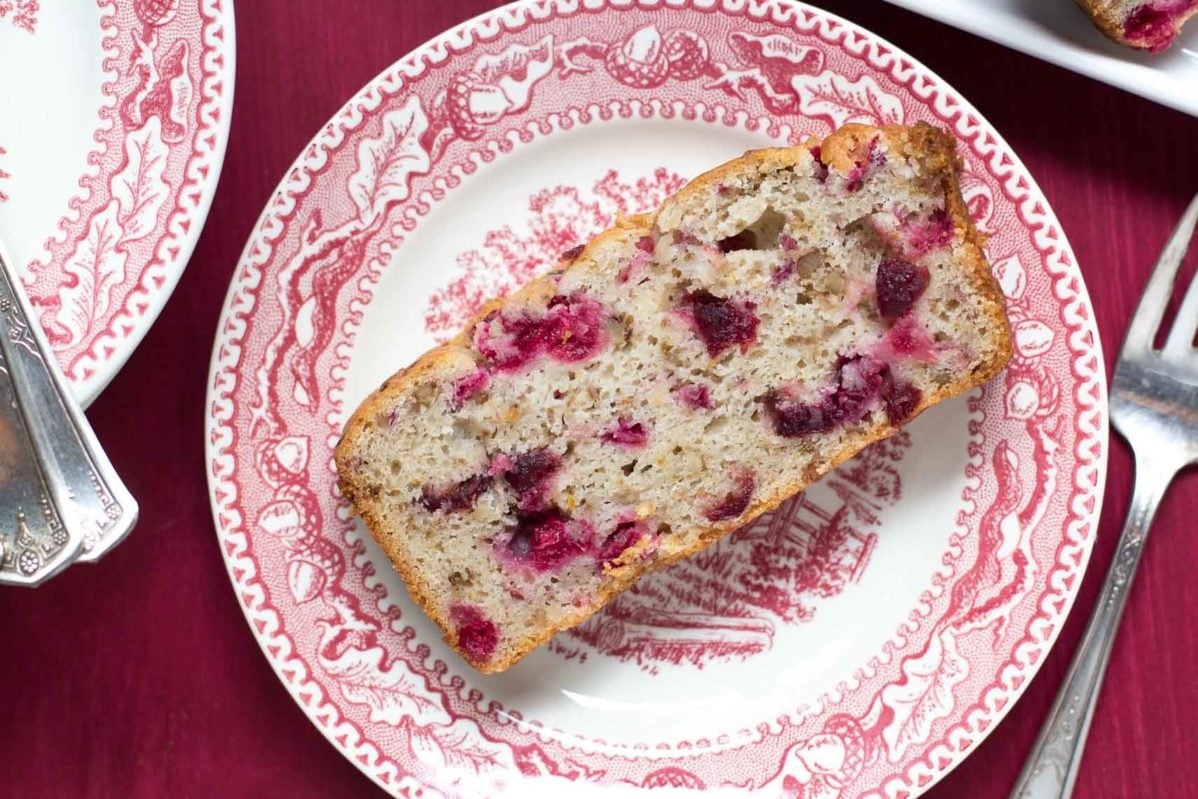
- Cranberry Quick Bread
- Ham with Cranberry Hot Pepper Glaze
- Raw Cranberry Orange Relish
- Savory Cranberry Sauce

- Spiced Citrus Cranberry Sauce
- Brown Sugar 5-Spice Cranberry Sauce
- Cranberry Horseradish Sauce
- Cranberry Sauce with Orange Marmalade
- Ginger Cranberry Sauce

- Baked Brie with Cranberries
- Cranberry White Chocolate Energy Bites
- Cranberry Oat Breakfast Cookies
- Cranberry White Chocolate Bars
- Cranberry Raspberry Trifle

- Red Velvet Cake with Sugared Cranberries
- Cranberry Cinnamon Swizzle Beverage
- Cranberry Almond Buttermilk Cake


